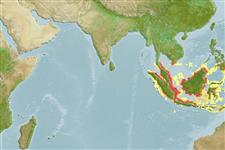Environment: milieu / climate zone / depth range / distribution range
Écologie
marin; saumâtre; océanodrome (Ref. 51243); profondeur 1 - 20 m (Ref. 6898). Tropical; 9°N - 11°S, 94°E - 126°E (Ref. 189)
Indo-West Pacific: only Penang, Malaysia in the Indian Ocean; southern Thailand to Singapore, southern Kalimantan, Java and Sulawesi. Records of this species from India refer to the rather similar Thryssa kammalensoides.
Taille / Poids / Âge
Maturity: Lm ? range ? - ? cm
Max length : 18.0 cm TL mâle / non sexé; (Ref. 125279); poids max. publié: 36.50 g (Ref. 125279)
Épines dorsales (Total) : 0; Épines anales: 0; Rayons mous anaux: 30 - 33. Belly with 23 to 25 (rarely 24 or 26) keeled scutes from isthmus to anus. Maxilla moderate, reaching just to gill opening or a little beyond in large fishes; first supra-maxilla about half of second. A diffuse dark `saddle' on nape.
Presumably schooling and occurring mostly inshore. More data needed based on correct identifications.
Life cycle and mating behavior
Maturities | Reproduction | Spawnings | Egg(s) | Fecundities | Larves
Wongratana, T., T.A. Munroe and M. Nizinski, 1999. Order Clupeiformes. Engraulidae. Anchovies. p. 1698-1753. In K.E. Carpenter and V.H. Niem (eds.) FAO species identification guide for fishery purposes. The living marine resources of the WCP. Vol. 3. Batoid fishes, chimaeras and bony fishes part 1 (Elopidae to Linophrynidae). FAO, Rome. (Ref. 9822)
Statut dans la liste rouge de l'IUCN (Ref. 130435)
Menace pour l'homme
Harmless
Utilisations par l'homme
Pêcheries: pêcheries vivrières
Outils
Articles particuliers
Télécharger en XML
Sources Internet
Estimates based on models
Preferred temperature (Ref.
123201): 28.4 - 29.4, mean 29 °C (based on 536 cells).
Phylogenetic diversity index (Ref.
82804): PD
50 = 0.5000 [Uniqueness, from 0.5 = low to 2.0 = high].
Bayesian length-weight: a=0.00501 (0.00360 - 0.00697), b=3.12 (3.07 - 3.17), in cm total length, based on LWR estimates for this species (Ref.
93245).
Niveau trophique (Ref.
69278): 3.4 ±0.4 se; based on diet studies.
Generation time: 3.3 ( na - na) years. Estimated as median ln(3)/K based on 1
growth studies.
Résilience (Ref.
120179): Milieu, temps minimum de doublement de population : 1,4 à 4,4 années (Preliminary K or Fecundity.).
Fishing Vulnerability (Ref.
59153): Low to moderate vulnerability (32 of 100).
